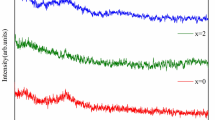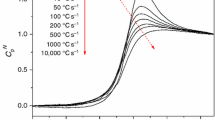Summary
EXAFS spectra of amorphous bulk selenium and Se80Te20 alloy have been analysed in the temperature range of the glass transition region (−15 to 37°C). α-Se shows an unexpected behaviour because the modulated part of the X absorption increases with the temperature, irrespectively of the action of the EXAFS Debye-Waller factor from which one expects an opposite behaviour. Analogous features do not appear in the Se80Te20 alloy, probably because of the role played by the intramolecular covalent Se−Te bond strength, weaker than the corresponding Se−Se. In the absence of suitable models for the temperature dependence of the microscopic processes occurring in glasses nearT g, a tentative explanation is proposed in terms of the temperature dependence of the backscattering amplitude functionF(k).
Riassunto
Il selenio amorfo e lega Se80Te20 sono stati studiati con tecnica EXAFS nell'intervallo delle temperature noto come regione della transizione vetrosaT g (da −15 a 37°C). Il selenio amorfo mostra un comportamento inaspettato per effetto dell'aumento, con la temperatura sottoT g, della parte modulata dell'assorbimento dei raggi X, in contrasto con quanto ci si aspetterebbe per l'effetto di smorzamento del fattore di Debye-Waller. Un comportamento analogo non si riscontra invece nella lega Se80Te20 dove, probabilmente, il legame covalente intracatena Se−Te, piú debole del corrispondente Se−Se, rende piú efficace l'azione di smorzamento del fattore di Debye-Waller, smascherando altri effetti. In assenza di modelli adeguati che descrivono la dipendenza dalla temperatura dei processi microscopici nei materiali vetrosi nella regione della transizione vetrosa, si ipotizza che il comportamento ≪anomalo≫ del selenio sia attribuibile ad una dipendenza dalla temperatura della funzione ampiezza di backscatteringF(k).
Резюме
Анализируются спектры EXAFS аморфного объемного селена и сплава Se80Te20 в области температур переходной области стекла (от 15° до 37°C). а-Se обнаруживает неожиданное поведение, потому что модулированная часть Х поглощения увеличивается с температурой, независимо от действия фактора дебая-Уоллера EXAFS, который предполагает противоположное поведение. Аналогичные особенности не возникают в сплаве Se80Te20, так как сила межмолекулярной ковалентной связи Se−Te, по-видимому, слабее, чем соответствующвя связь Se−Se. В отсутствии соответствующих моделей для температурной зависимости микроскопических процессов, происходящих в стеклах вблизиT g,a, предлагается предварительное объяснение в терминах температурной зависимости функцииF(k) амплитуды обратного рассеяния.
Similar content being viewed by others
References
G. Galli, P. Migliardo, R. Bellissent andW. Reichardt:Solid State Commun.,57, 195 (1986).
G. Carini, M. Cutroni, M. Federico andM. Federico andG. Galli:J. Non-Cryst. Solids,64, 29 (1984).
P. A. Lee, P. H. Citrin, P. Eisenberger andB. M. Kincaid:Rev. Mod. Phys.,53, 769 (1981).
The values of the scattering amplitude functionF(k) and phase shifts ϕ(k), used here, have been calculated fromBoon-Keng Teo, P. A. Lee, A. L. Simons, P. Eisenberger andB. M. Kincaid:J. Am. Chem. Soc.,99, 3854 (1977);P. A. Lee, Boon-Keng Teo andA. L. Simons:J. Am. Chem. Soc.,99, 3856 (1977);Boon-Keng Teo andP. A. Lee:J. Am. Chem Soc.,101, 2815 (1979).
An analogous experimental behaviour on the X-ray structure factor of As2S3 has been found byL. E. Busse andS. R. Nagel:Phys. Rev. Lett.,47, 1848 (1981);C. Lin, L. E. Busse, S. R. Nagel andJ. Faber:Phys. Rev. B,29, 5060 (1984).
R. Bellissent:Nucl. Instrum. Methods,199, 289 (1982).
G. Galli, G. Maisano, G. Migliardo, C. Vasi, F. Wanderlingh andM. P. Fontana:Solid State Commun.,42, 213 (1982).
R. Bellissent andG. Tourand:J. Non-Cryst. Solids,35 & 36, 1221 (1980).
E. A. Stern, D. E. Sayers andF. W. Lytle:Phys. Rev. B,11, 4836 (1975);W. Bohmer andP. Rabe:J. Phys. C,12, 2465 (1979);R. B. Greegor andF. W. Lytle:Phys. Rev. B,20, 4902 (1978).
M. Abkowitz andD. M. Pai:Phys. Rev. B,18, 1741 (1978).
Author information
Authors and Affiliations
Rights and permissions
About this article
Cite this article
Federico, M., Galli, G., Magazù, S. et al. Study of the glass transition region in amorphous selenium by EXAFS. Il Nuovo Cimento D 10, 425–434 (1988). https://doi.org/10.1007/BF02450132
Received:
Published:
Issue Date:
DOI: https://doi.org/10.1007/BF02450132




